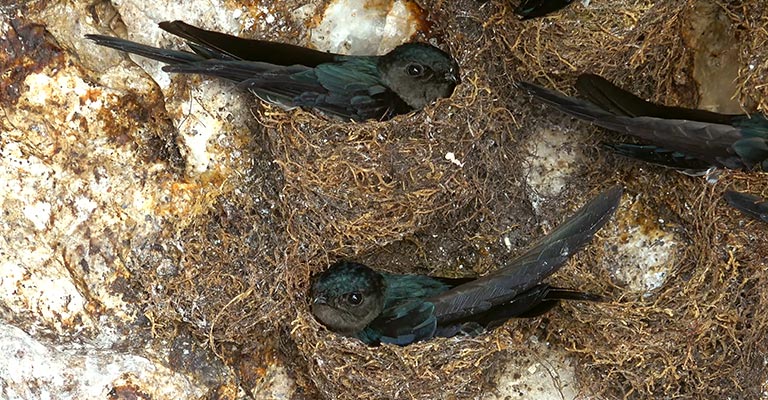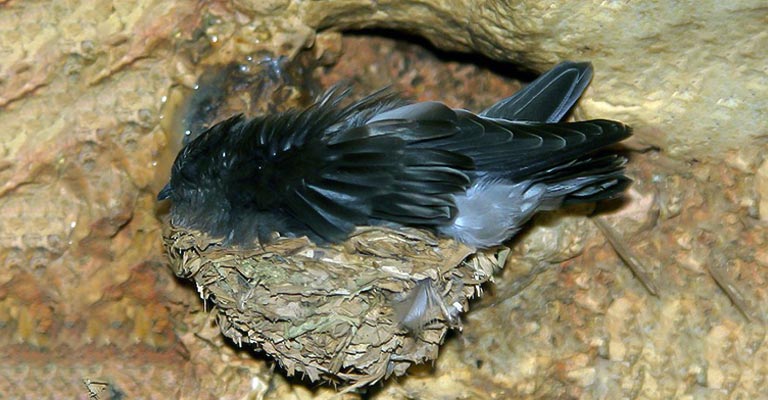The Mariana Swiftlet (Aerodramus Bartsch) is a captivating avian species endemic to the Mariana Islands in the western Pacific Ocean.
Renowned for its agile flight and communal nesting habits, this small bird plays a vital ecological role as a predator of flying insects and contributes to pollination dynamics within its island habitat.
With its glossy plumage and distinctive behavioral adaptations, the Mariana Swiftlet stands as a symbol of resilience in the face of environmental challenges.
Understanding its unique characteristics and conservation needs is essential for preserving the delicate balance of the Mariana Islands’ ecosystems. Stay focused.
Identifying Criteria of Mariana Swiftlet

Identifying the Mariana Swiftlet (Aerodramus Bartsch), a small, agile bird native to the Mariana Islands in the western Pacific, requires attention to specific criteria due to its similarities with other swiftlet species.
Here are some of the key points to help in its identification:
Size and Shape
Mariana Swiftlets are relatively small birds with a streamlined body shape, adapted for swift, darting flight.
They typically measure around 10 to 12 centimeters in length, with short, rounded wings and a slightly forked tail. Observing these proportions can help distinguish them from similar species.
Coloration
Their plumage is predominantly dark brown or blackish, often appearing glossy in sunlight. While observing them in flight, look for any distinguishing marks or patterns on their wings or body, although they tend to lack distinctive markings.
Flight Pattern
Mariana Swiftlets are known for their swift and erratic flight, characterized by rapid wingbeats interspersed with glides.
They frequently fly in tight formations, mainly when foraging for insects in the air. Attention to their flight pattern can aid in identification, especially in mixed-species flocks.
Habitat Preference
These swiftlets inhabit various habitats within the Mariana Islands, including forests, caves, cliffs, and occasionally urban areas.
They typically roost and nest in dark, inaccessible caves or cliff crevices. Observing their preferred habitats can provide clues to their identity.
Vocalizations
While not as vocal as some bird species, Mariana Swiftlets produce faint, high-pitched chirps and twittering sounds, especially around their nesting sites.
Familiarizing oneself with their vocalizations can be helpful, although they may be challenging to hear amidst other environmental noises.
Nesting Behavior

Mariana Swiftlets construct cup-shaped nests made of saliva that attach to vertical surfaces within caves or crevices.
Monitoring nesting colonies, especially during breeding seasons, can facilitate identification by observing their unique nest structures and behaviors.
Range and Distribution
As endemic birds to the Mariana Islands, Mariana Swiftlets have a limited distribution range. Understanding their range within the archipelago and their seasonal movements, if any, can aid in targeted sightings.
Behavioral Characteristics
Observing their behavior in various contexts, such as foraging, mating displays, or interactions with other individuals, can provide valuable insights into their identity.
Mariana Swiftlets often forage in groups, darting and maneuvering adeptly to catch flying insects.
Identifying Mariana Swiftlets requires a holistic approach, considering their physical characteristics, behavior, habitat preferences, and vocalizations.
Attention to detail and familiarity with their distinct traits are crucial for accurate identification, especially given their similarities with other regional swiftlet species.
Taxonomy of Mariana Swiftlet
The table below shows the taxonomy details of Mariana Swiftlet based on the provided information:
| Taxonomic Level | Classification |
| Domain | Eukaryota |
| Kingdom | Animalia |
| Phylum | Chordata |
| Class | Aves |
| Clade | Strisores |
| Order | Apodiformes |
| Family | Apodidae |
| Genus | Aerodramus |
| Species | A. bartschi |
The Mariana Swiftlet (Aerodramus bartschi) belongs to the Apodidae family, encompassing swifts and swiftlets.
It is classified under the genus Aerodramus, which consists of small, fast-flying birds characterized by their streamlined bodies and aerial foraging habits.
Within the species bartschi, the Mariana Swiftlet is recognized as a distinct subspecies endemic to the Mariana Islands in the western Pacific Ocean.
Taxonomically, it falls within the order Apodiformes, which includes swifts and hummingbirds, and the class Aves, encompassing all bird species.
Common Food of Mariana Swiftlet
The Mariana Swiftlet primarily feeds on a diet of small flying insects, which it catches in flight using its agile aerial maneuvers. Some common foods in its diet include:
- Flying Insects: Mariana Swiftlets predominantly feed on small flying insects such as flies, mosquitoes, ants, beetles, and other aerial invertebrates.
- Flying Termites: Termites that take to the air during swarming events are also a favored food source for Mariana Swiftlets.
- Flying Ants: Similarly, flying ants make up a portion of their diet, especially during ant swarms.
- Other Invertebrates: While insects form the bulk of their diet, Mariana Swiftlets may also opportunistically consume other small invertebrates encountered during flight.
These swiftlets are adept aerial hunters, utilizing their swift flight and agile maneuvers to capture prey on the wing, making flying insects their primary and most common food source.
Mariana Swiftlet’s Life History
The Mariana Swiftlet (Aerodramus bartschi) is a small, insectivorous bird native to the Mariana Islands in the western Pacific Ocean.
As a flying insect predator, this species plays a crucial role in the island ecosystem and contributes to pollination and nutrient cycling.
Understanding its history provides valuable insights into its ecological significance and conservation needs.
Habitat
Mariana Swiftlets inhabit various habitats within the Mariana Islands, including forests, cliffs, caves, and urban areas. They are particularly associated with cave systems where they roost and nest, often in large colonies.
Range Map
The range of the Mariana Swiftlet is confined to the Mariana Islands, including Guam, Rota, Tinian, and Saipan. They are endemic to these islands and are not found elsewhere.
Nesting
Mariana Swiftlets construct cup-shaped nests using saliva, which attach to vertical surfaces within caves or crevices.
Nesting colonies can vary in size, with numerous nests clustered together in suitable locations. These nests serve as sites for breeding and rearing offspring.
Here’s a table detailing the nesting details of the Mariana Swiftlet:
| Nesting Details | Description |
| Clutch Size | 1-2 eggs |
| Number of Broods | Typically 1 per breeding season |
| Egg Length | Approximately 1.5 centimeters |
| Egg Width | Approximately 1.0 centimeter |
| Incubation Period | Around 18-20 days |
| Nestling Period | Approximately 4-5 weeks from hatching |
| Egg Description | Small, oval-shaped, white or creamy |
| Nest Construction | Often, large colonies with numerous nests clustered together |
| Nesting Colonies | Usually, large colonies with multiple nests clustered together |
This table summarizes vital nesting details of the Mariana Swiftlet, providing insights into its reproductive biology and nesting behavior.
Mariana Swiftlets exhibit communal nesting habits, forming large colonies in caves or crevices where they construct cup-shaped nests made of saliva.
These nests are attached to vertical surfaces, providing a secure environment for breeding and rearing offspring.
Typically, each nest contains one to two small, oval-shaped eggs, which both parents incubate for about 18-20 days. After hatching, the nestlings are cared for by both parents and undergo a nestling period lasting approximately 4-5 weeks before fledging.
This communal nesting behavior allows efficient use of suitable nesting sites and facilitates social interactions among colony members.
Breeding
Breeding typically occurs during the warmer months, with specific timing varying by location and environmental conditions.
Courtship displays involve aerial acrobatics and vocalizations. Females lay one or two eggs per clutch, and both parents share incubation and chick-rearing duties.
Diseases
Mariana Swiftlets may be susceptible to avian malaria, fungal infections, and parasitic infestations. These health issues can impact population numbers and reproductive success.
Treatment
Conservation efforts may include monitoring for disease outbreaks, implementing habitat management practices to reduce disease transmission, and providing supplemental feeding or medical intervention when necessary.
Research into disease prevention and treatment strategies is ongoing.
Conservation
The Mariana Swiftlet faces various threats, including habitat loss, introduced predators, and disturbances to nesting sites.
Conservation efforts focus on protecting and restoring suitable habitats, managing invasive species, and raising awareness about preserving these birds and their ecosystems.
10 Behavioral Habits of Mariana Swiftlet
The Mariana Swiftlet (Aerodramus bartschi) exhibits a fascinating array of behavioral habits that contribute to its survival in its native habitats of the Mariana Islands.
These small, agile birds display various behaviors adapted to their aerial lifestyle and communal nesting habits.
- Aerial Foraging: Mariana Swiftlets are adept aerial hunters, catching flying insects such as flies, mosquitoes, and ants while in flight. Their swift and agile flight allows them to capture prey with precision.
- Communal Nesting: These swiftlets form large nesting colonies in caves or crevices, where multiple nests are clustered together. This communal nesting behavior facilitates social interactions and offers protection against predators.
- Nest Building: Mariana Swiftlets construct cup-shaped nests using saliva, which attach to vertical surfaces within caves or crevices. Nest building is collaborative, with both males and females contributing to nest construction.
- Incubation Duties: Both male and female Mariana Swiftlets take turns incubating the eggs, sharing the responsibility of ensuring the eggs’ warmth and protection.
- Parental Care: After hatching, both parents feed and care for the nestlings. They regurgitate food to feed their offspring, ensuring their growth and development.
- Vocalizations: While not as vocal as some bird species, Mariana Swiftlets produce faint, high-pitched chirps and twittering sounds, especially around their nesting sites. These vocalizations may serve as communication signals within colonies.
- Social Interactions: Within nesting colonies, Mariana Swiftlets engage in various social behaviors, including courtship displays, mutual preening, and territorial defense.
- Roosting Behavior: Outside of the breeding season, Mariana Swiftlets roost communally in caves or other sheltered locations, often in large numbers.
- Aerial Acrobatics: Their swift and agile flight allows them to perform impressive aerial maneuvers, including sudden dives, sharp turns, and rapid changes in direction, which are essential for catching flying insects.
- Migration: While not known for long-distance migrations, Mariana Swiftlets may undertake seasonal movements within the Mariana Islands in response to changes in food availability or environmental conditions. These movements are typically localized and may involve shifts between roosting and foraging sites.
Wrapping Up
The Mariana Swiftlet exemplifies remarkable behavioral adaptations suited to its aerial lifestyle and communal nesting habits.
From agile foraging and collaborative nest-building to shared parental care and intricate social interactions within colonies, these behaviors underscore the species’ resilience and significance within its island ecosystem.
Understanding and preserving these behavioral traits are crucial for ensuring the Mariana Swiftlet’s continued survival and conserving its unique habitat. Thank you very much.